Introducing The New Makito X4

Haivision has just released their latest in reliable and legendary video over IP encoders. Introducing the Makito X4. For ultra-low 4K and HD video streaming over IP. The Makito X4 is a highly secure video encoder with exceptional video quality and next-generation performance. It also features SRT streaming and the highest available 4K UHD and HD encoding density. The Makito X4 is ideal for remote production and live broadcast.
The Makito X4 is ideally suited for interactive video applications such as live interviews as well as field contribution, backhaul and return feed confidence monitoring. The Makito X4 features SreamSync technology, unique to Haivision, making it possible to stream multiple cameras feeds over IP for synchronized multi-cam playback enabling remote production.
The Makito X4 provides quality, power, and flexibility for real-time HEVC/AVC video encoding in a compact or rack-mountable appliance. This new encoder is designed for the most demanding live video applications – this encoder can ingest full 4K UHD or up to four HD inputs with 10-bit pixel depth and 4:2:2 chroma subsampling, a type of compression that reduces the color information in a signal in favor of luminance data. This reduces bandwidth without significantly affecting picture quality.
The Makito X4 provides eight powerful encoding cores that can deliver low latency, multi-bitrate streams over any IP network securely and simultaneously. Offering native support for the SRT protocol making it ideal for streaming over unpredictable networks such as the public internet.
 The small compact design of the Makito X4 makes it a portable appliance that is ideal for use on mobile platforms and in remote locations. But for centralized deployments, the Makito X4 blades provide the highest channel density available. Up to 84 HD or 21 UHD video sources within a single 4RU rack module.
The small compact design of the Makito X4 makes it a portable appliance that is ideal for use on mobile platforms and in remote locations. But for centralized deployments, the Makito X4 blades provide the highest channel density available. Up to 84 HD or 21 UHD video sources within a single 4RU rack module.
So here’s a quick rundown of what the new Makito X4 offers:
- Full frame rate 4K UHD or quad HD support
- Highest available encoding density – up to an amazing 84 HD or 21 4K sources encoded in a single chassis!
- Exceptional broadcast quality video – HEVC/H.265 and AVC/H.264 live encoding supporting 4:2:2 10 bit color
- Ultra-low latency – ideal for remote interactive applications such as live interviews and remote production/REMI
- 8 encoding cores – flexibility to deliver HEVC or H.264 streams at multiple bitrates to multiple locations
Zoom Room Amazing Audio Options
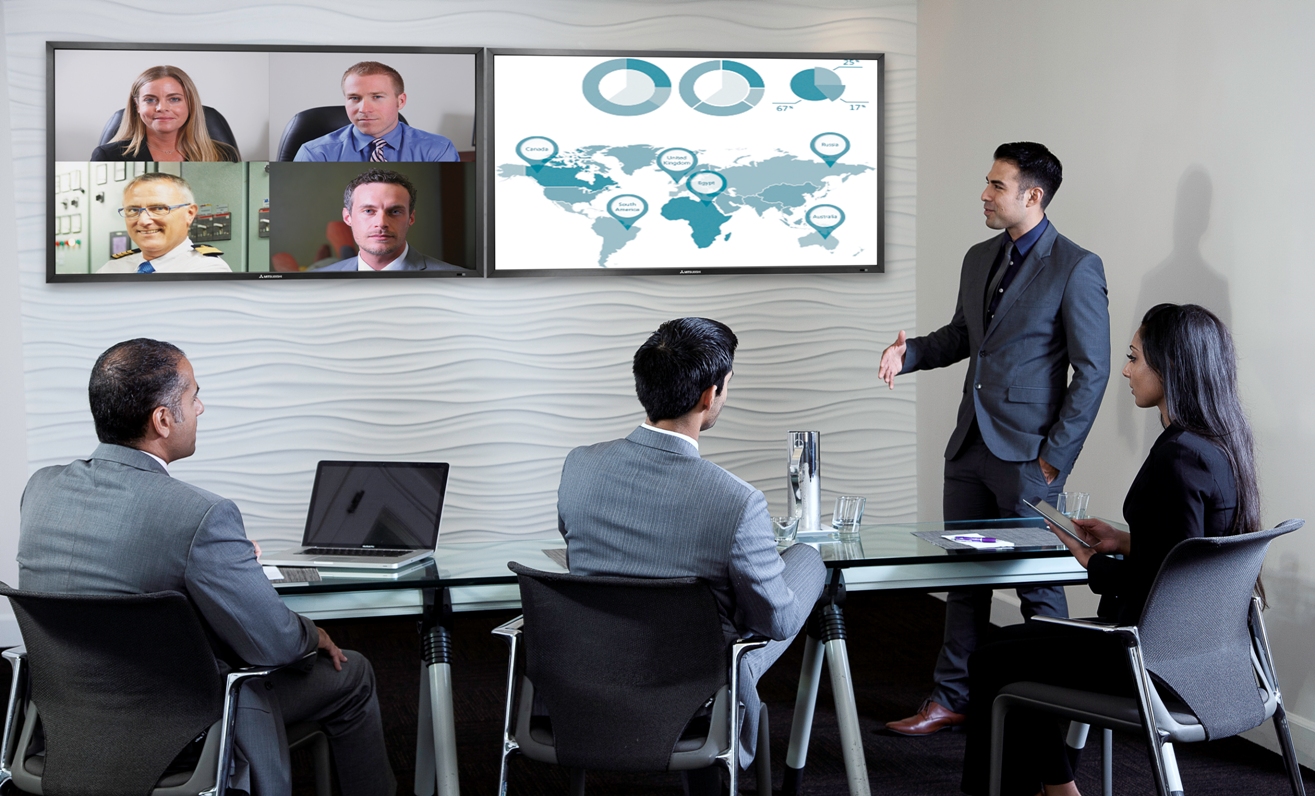
Simple Solution
Larger Zoom Rooms have always had difficulties in the past. Hearing and being heard regardless of where team members are in the room has been a challenge. Getting professional audio and microphone systems installed and calibration set up could add up costs and easily take to room offline for a time. Fortunately, there is a better way with Philm Gear’s Zoom Room amazing audio options.
A Better Way
 Philm Gear Audio Solutions is your new answer to large room video conferencing audio. This new audio technology fills a space so you get true full-room pickup. Simple installation and calibration make downtime for the room negligible. Your team is up and running with a fully functioning, easy to hear and be heard, even if moving around the room, audio and microphone system.
Philm Gear Audio Solutions is your new answer to large room video conferencing audio. This new audio technology fills a space so you get true full-room pickup. Simple installation and calibration make downtime for the room negligible. Your team is up and running with a fully functioning, easy to hear and be heard, even if moving around the room, audio and microphone system.
- Simple Installation: Our audio systems can be installed in less than an hour. Use with Zoom or any Video Conferencing platform. There are no drivers to install.
- Auto-Calibration: No required initial and ongoing calibration. Once installed, calibration is automatic.
- Room Manager: You may choose to customize your audio and input settings and keep your system current with automatic updates.
 One of Philm Gear’s solutions is the HDL300. How the HDL300 system works is with Microphone Mist technology, an entirely new approach to audio conferencing, which fills the room with thousands of virtual microphones. For the first time, meeting participants can be heard no matter where they move in the room or which direction they face.
One of Philm Gear’s solutions is the HDL300. How the HDL300 system works is with Microphone Mist technology, an entirely new approach to audio conferencing, which fills the room with thousands of virtual microphones. For the first time, meeting participants can be heard no matter where they move in the room or which direction they face.
This option is only available with the HDL300 system, which includes a microphone array and speakers in a unit that can be hung on the wall anywhere in a meeting room, which is a new approach to meeting room microphones.
The HDL300’s advanced system processing capability, which can handle 15,000 MIPS (millions of instructions per second), allows the system to process sound from all of its virtual mics in real time. It focuses on the cleanest sound sources, without gating or clipping, and optimizes them for distortion-free, natural-sounding conversations. This mitigates the problems of dead zones and limited range. The result is an  excellent experience for remote participants.
excellent experience for remote participants.
The HDL300 is designed for small to mid-sized rooms up to 30′ x 30′ (9.14 x 9.14 m). The Dual HDL300 can accommodate large rooms up to 30′ x 50′ (9.14 x 15.24 m). Both are designed to facilitate active collaboration where meeting participants move freely about the room to engage with other team members and interact with displays. Simple installation requires less down time for the room.
Calibration and maintenance for changes in room or number and movement of participants is automatic. Firmware updates are also automatic through the included an audio manager. Little or no maintenance is required.
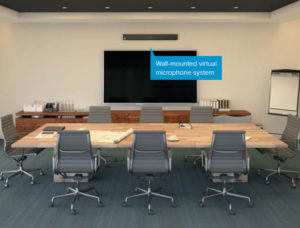 These wall-mounted units are inconspicuous and professional looking for pleasing esthetics.
These wall-mounted units are inconspicuous and professional looking for pleasing esthetics.
Virtual microphone technology also solves “problem rooms.” Reactive surfaces, HVAC, movable furniture and dead zones are problem room ingredients that can confound conventional systems. Virtual microphone technology allows the HDL300 system to focus on the highest processing gain value (typically a person talking) and intelligently presents background sounds proportionately to the desired audio. Add in the system’s high-quality stereo speakers, and the result is a premium audio experience.
Video conferencing has become commonplace and is a key component on how businesses with multiple locations stay connected. Even more commonplace, however, is problems with microphones and audio. But this doesn’t need to be the case. Let us help you get the best quality audio to finally be able to hear and be heard clearly.
Mass Notification to Inform and Instruct

Emergencies in your office building can happen. We rarely think about fires or other types of emergencies when heading to work for the day, but each organization has to be prepared should such an unthinkable event occur. Fire alarm systems have been in place for a long time, but what else can be done to help keep our workforce safe in the event of an emergency? We are proud to introduce Mass Notification Systems to inform and instruct should any emergency come up.
The n.FORM Mass Notification System by Lencore (see are list of brands here), is a solution that meets the requirements of the National Fire Protection Association’s (NFPA) code 72. n.FORM has achieved Underwriter Laboratories (UL) listing, UL 2572, for a mass notification system from a Nationally Recognized Testing Laboratory (NRTL). UL 2572 allows the n.FORM system to interface with a Fire Alarm Control Panel (FACP) in order to reinforce the fire alarm as well as take control in a non-fire emergency.
There are four criteria that need to be met in any Mass Notification and Emergency Communications system.
Reporting provide real-time notifications should the system be tampered with or any component of the system is compromised. Alerts are automatically sent so that the issues can be resolved.
Redundancy is the system’s built in fail safes. Notification will be sent to you if there is a compromise in the system and also ensure 24/7 operability.
Reach is about getting to all the intended audience to inform and instruct. Reach can be audible or visual throughout the entire facility.
Clarity is the degree to which the audience understands the message they are receiving.
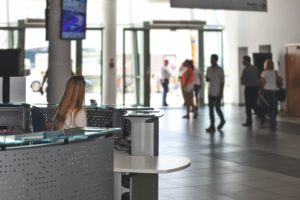 Within the National Fire Protection Association’s (NFPA) code 72, specific communication requirements must be met. Specifically, a Mass Notification system must provide for Acoustically Distinguishable Spaces (ADS) as well as meet the Sound Transmission Index for Public Address (STIPA) Together, these performance standards help to achieve “intelligibility” – another requirement within NFPA72.
Within the National Fire Protection Association’s (NFPA) code 72, specific communication requirements must be met. Specifically, a Mass Notification system must provide for Acoustically Distinguishable Spaces (ADS) as well as meet the Sound Transmission Index for Public Address (STIPA) Together, these performance standards help to achieve “intelligibility” – another requirement within NFPA72.
To provide coverage to all of the intended audience, the overall space is reviewed and evaluated to consider each Acoustically Distinguishable Space (ADS) in order to define the appropriate zoning requirements for the client’s facilities. Identifying and understanding the local and global communication needs of the organization plays a vital role in the design strategy. Our on-site consultation covers all aspects of reviewing the needs of your unique space and provides information regarding meeting those needs.
System Design Considerations
A variety of visual and audio delivery methods can be customized into the design and integrated to ensure that messages are seen and heard clearly. Audio coverage utilizes a variety of audible devices such as upward-firing, direct-firing and specialty speakers and horns for both overhead and loud speaker paging. The speaker design always considers and meets criteria for the necessary volume fluctuations.
A well designed Mass Notification solution will ensure that all intended audiences are well informed and directed to safety through any and all means possible. Here are some other design features:
- Surge & Uninterruptible Power Supply Systems
- Pre-Recorded Announcements
- Preventative Maintenance
- Intelligibility
- Prioritization
- Buildings
- Controls
- Content
- Zoning
While most do not want to have to consider the “what ifs” that could happen in your office space, each organization must have a plan in place for how they will notify all individuals in the building should they need to get out to safety. Our Mass Notification system will do that and more, while meeting the NFPA codes, ensuring your team is safe.
What Is Sound Masking
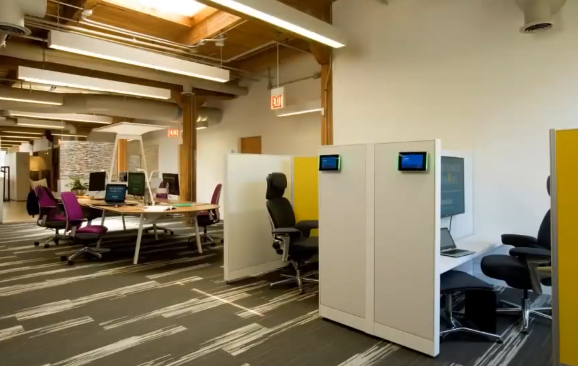
In this post, we will be talking about Sound Masking, a way to increase privacy in the workplace.
Many modern office spaces are designed with an open layout. The idea behind the open concept is to increase collaboration within the organization. These open spaces often increase workflow by allowing each team member easy access to one another. There are drawbacks to the open concept, and that is lack of privacy.
Sound Travels
Sound is a wave that spreads out in all directions from a source. Walls block it, soft surfaces absorb it and it’s reflected by hard surfaces. Some sounds can cover it up. But unimpeded, sound can travel pretty far.
Even soft sounds are easy to hear if there’s nothing to cover or otherwise impede the sound from being detected by your ears.
What is Sound Masking?
Sound Masking is the addition of an unstructured sound to an environment that fills in the sound spectrum and makes the structured sound of human speech less intelligible. Less intelligible speech = privacy. Usually it’s an un-intrusive sound like airflow, similar to a typical modern HVAC system. The Philm Gear Team can customize for your open work spaces.
Achieving Speech Privacy
Block, Absorb or Cover are three ways that can improve your acoustic environment and achieve the necessary privacy. Sound waves can be blocked by using high-STC-rated panels, partitions, windows and walls. Sound can be absorbed by using a high-NRC-rated ceiling tile or acoustic wall panels. Sound can be covered by using a source of unstructured–NOT music which is structured and therefore distracting–low-level background sound, known as Sound Masking or white noise.
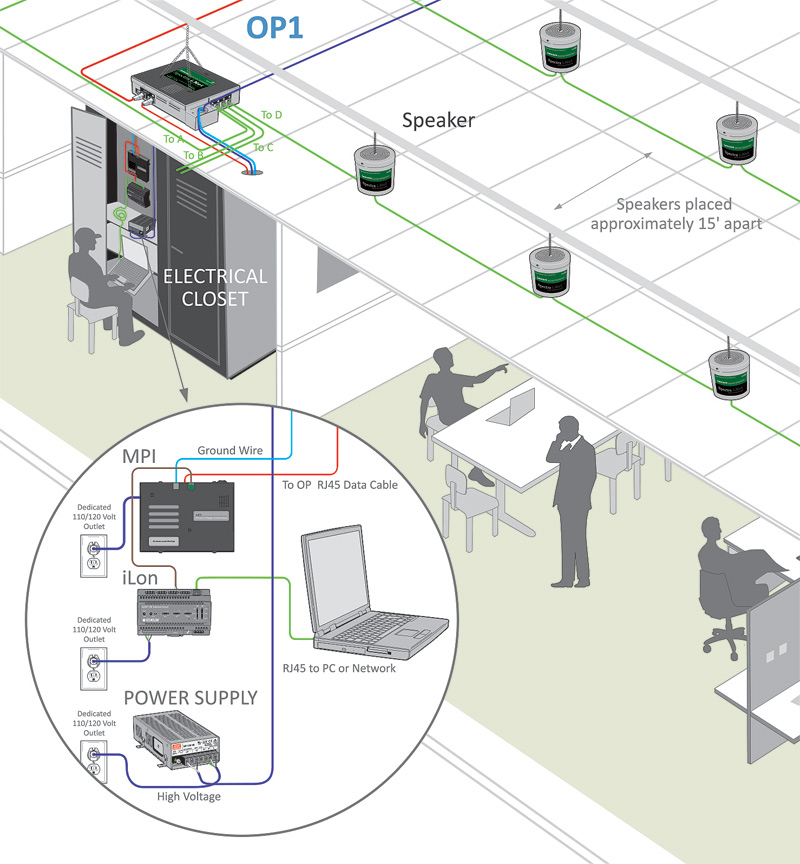 Most office environments will require some combination of these three tools to provide an acoustically pleasing atmosphere. In most cases, no one tool by itself will solve your privacy needs, however, covering or Sound Masking provides the greatest increase in privacy per dollar invested. It’s even more effective if used in conjunction with the proper mixture of Absorption and Blocking components in order to achieve specific speech privacy levels.
Most office environments will require some combination of these three tools to provide an acoustically pleasing atmosphere. In most cases, no one tool by itself will solve your privacy needs, however, covering or Sound Masking provides the greatest increase in privacy per dollar invested. It’s even more effective if used in conjunction with the proper mixture of Absorption and Blocking components in order to achieve specific speech privacy levels.
We Meet The 5 Criteria For Comfort
- Broadband sound 65hz – 13Khz
- Good wraparound, no noticeable repeat
- Multiple noise sources, randomness is relaxing
- Uniformity of sound, +/- 1dB
- Tuning Flexibility, easily adjusted for privacy and comfort
Our Sound Masking Solutions Provide
- Virtually limitless zoning capabilities, easy expansion, and complete system access with the click of the remote or mouse, on site, off-site or around the world.
- It is best for 20,000 square feet to projects requiring multiple facilities / campus wide installations.
- A networked system with plug and play components with real time system access, control, monitoring, and reporting.
- Provides point-by-point technical advantages in tuning, control and coverage.
Our solutions will give you both individualized and central speaker control. Most Sound Masking systems need to be attended to regularly and maintained annually to keep from degrading over time. We ensure sound uniformity with no re-tuning requirements.
Most offices have multiple distinct sound signatures (Such as a call center vs. reception area) unlike the competition, our sound masking levels can be customized to areas as small as 225 sq. ft. Most other systems mask in half- or full-floor zones. Because Spectra systems can be so finely tuned, you can be confident in uniform, comfortable speech privacy.
All Sound Masking solutions by Philm Gear are UL Listed so that you can be confident that your system will meet code requirements.
Knowing the Codes
NFPA72: Fire Alarm & Signaling and UL 2572 / ULC-S576
Sound masking systems installed in mid- to large-sized projects where NFPA72 is enforced must be UL Certified by a Nationally Recognized Testing Laboratory (NRTL). The reasoning behind this requirement is sound masking systems impede on the annunciation of emergency communications systems. UL 2572 and ULC-S576 are the US and Canadian testing standards, respectively, for approved equipment performance in mass notification systems. In order to certify that a system can perform the sound masking shutdown sequence requirement, the system control panel interfacing with the Fire Alarm Control Panel (FACP) must pass UL 2572 and/or ULC-S576. Any sound masking control panel connected directly with a FACP must be monitored to insure shutdown in the event of an emergency. Following are specifics extracted from the codes and the testing procedures highlighting the necessities to insure life safety:
NFPA72 2010 – 2016 versions states:
- Chapter 3: Emergency Communications Systems — Combination. 3.3.86 Various emergency communication systems such as fire alarm, mass notification, fire fighter communications, area of refuge communications, elevator communications, or others that can be served through a single control system or through an interconnection of several control systems.
- 3.95.1 (2010) / 3.3.103.1 (2016) Combination System. A fire alarm system in which components are used, in whole or in part, in common with a non-fire signaling system.
- 3.3.95.1 (2010) / A.3.3.103.1 (2016) Examples of non-fire systems are security, card access control, closed circuit television, sound reinforcement, background music, paging, and sound masking.
- Chapter 10: Fundamentals. The scope of this chapter includes requirements for equipment suitability and compatibility, power supplies, signal distinction and priority and distinction of signals, signal indication, fundamental equipment performance, protection of fire alarm systems, annunciation and annunciation zoning, monitoring integrity of power supplies, and impairments.
- Chapter 12: Circuits and Pathways. Addresses the performance and survivability characteristics of pathways (interconnections) used in fire alarm and signaling systems.
- 6.1 Unless otherwise permitted or required by 12.3.1 through 12.3.7 and 12.6.3 through 12.6.13, all means of interconnecting equipment, devices, and appliances and wiring connections shall be monitored for the integrity of the interconnecting conductors or equivalent path so that the occurrence of a single open or a single ground-fault condition in the installation conductors or other signaling channels is automatically indicated within 20 seconds.
- Chapter 18: Notification Appliances. 18.4.3.5 A signaling system arranged to stop or reduce ambient noise shall comply with 18.4.3.5.1 through 18.4.3.5.3.
- 4.3.5.3 Relays, circuits, or interfaces necessary to stop or reduce ambient noise shall meet the requirements of Chapters 10, 12, 21, and 23.
- Chapter 23: Protected Premises Fire Alarm Systems. As a minimum, where fire alarm systems SLCs are shared with other systems, the requirements of 23.8.2.6 and 23.8.4.3 apply and wiring for other systems must comply with the requirements of the NEC. Special care must be taken to ensure that the function or malfunction of other systems does not interfere with the operation of the fire alarm system.
- Chapter 23: While fire alarm systems are permitted to share circuits with non-fire alarm systems or components, the circuits are required to be arranged such that operation of the non-fire alarm system equipment or a non-fire alarm system component does not impair the operation of the fire alarm system. Extensive testing may be required to ensure that this requirement is met under all possible operating conditions and all possible combinations of events.
- Chapter 24: Emergency Communications System. 24.2.1 The systems covered under 24 are for the protection of life by indicating the existence of an emergency situation and communicating information necessary to facilitate an appropriate response and action.
- 24.3.7 Conflicting or competing signals or messages from different systems could be very confusing to occupants and have a negative impact on the intended occupant response. Where independent systems using audible and/or visible notification are present, the emergency communications system needs to interface with those systems to effect related control actions such as deactivating both audible and visible notification appliances.
- 5.1.1 Interconnection of protected premises emergency control functions with the mass notification systems shall comply with Chapter 21.
Underwriters Laboratories (UL) has designed certification tests (UL 2572 and ULC-S576) in order to ensure a product achieves a minimum level of performance to work with and not damage a fire alarm control panel in addition to being reliable. Successfully passing the battery of tests to achieve the certification helps insure product performance in the actual event of an emergency. The equipment must be capable to perform its intended functions in all environmental conditions to meet life safety codes.
Americans with Disabilities Act (ADA)
The ADA ensures access to the built environment for people with disabilities. The ADA Standards establish design requirements for the construction and alteration of facilities subject to the law. These enforceable standards apply to places of public accommodation, commercial facilities, and state and local government facilities.
NFPA 72 recognizes the ADA and references it in the code:
A.10.12 it is the intent that both visual and audible appliances are shut off when the notification appliance silence feature is activated on the fire alarm control unit. Per the ADA, it is important not to provide conflicting signals for the hearing or visually impaired.
18.5 The Americans with Disabilities Act and Architectural Barriers Act Accessibility (ADA/ABA) Guidelines references NFPA 72. The ADA/ABA and ADAAG continue to trigger upgrades of existing fire alarm systems. Almost all local jurisdictions have adopted some form of accessibility code or have incorporated the concepts directly into their building and fire codes, which then reference and require use of NFPA 72.
Purchasing vs. Renting AV Equipment

 So, you’re ready to get set up with some high-end AV equipment, but you’re not sure if renting or purchasing is the right way to go. That’s OK, we’ll walk you through the pros and cons of both to help you decide the best way to go.
So, you’re ready to get set up with some high-end AV equipment, but you’re not sure if renting or purchasing is the right way to go. That’s OK, we’ll walk you through the pros and cons of both to help you decide the best way to go.
Renting: This is a great choice if you’re looking for equipment that you’ll be using short term. For example: are you using it for a training seminar, a project, a show, or special event? Renting can provide you a lower investment as opposed to purchasing, especially if you’re only going to use the equipment for a short time. You can choose customized solutions that make it easy, and have what you need for that event, then return the equipment. Renting is also an excellent option if you’re looking to keep up with the latest technology. You can upgrade whenever, without committing to a purchase.
Purchasing: This option is a good choice for those looking for a more long-term use. If you plan to use your equipment often for presenting, meetings, advertising, etc. then buying is your ideal option. You won’t have to worry about rental costs, you’ll own your equipment, and you even have the option to sell it when you’re done with it. While, some companies would say that purchasing comes with cons like having to maintain it and do the research yourself, we’ll tell you otherwise.
Regardless if you’re renting or purchasing, we offer an array of services. We’ll make sure that you get the best value for your time and budget needs. Let us do the research for you. We also offer setup and maintenance, so all you have to do is focus on your job; we’ll do the rest.


